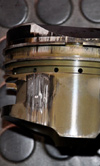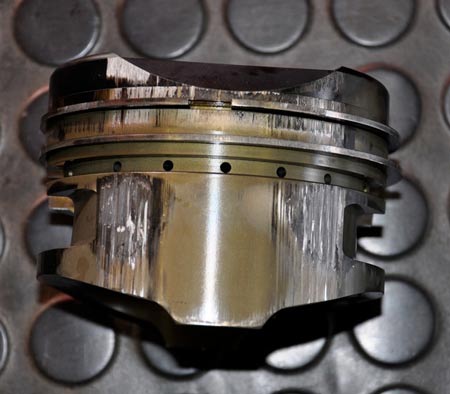Top Fuel cylinder scuffing
 Success in the Top Fuel category of NHRA Full Throttle Drag Racing Series competition relies on many different factors, but always comes down to the tuner's success in predicting the atmospheric conditions, the amount of clutch necessary to propel the car and making the right tune-up decisions.
Success in the Top Fuel category of NHRA Full Throttle Drag Racing Series competition relies on many different factors, but always comes down to the tuner's success in predicting the atmospheric conditions, the amount of clutch necessary to propel the car and making the right tune-up decisions.
Chasing the perfect combination is always the mantra for crew chiefs and tuners in the Top Fuel game - and anyone who doesn't admit that they're chasing the top teams from Al-Anabi Racing and Don Schumacher Racing is, frankly, lying.
Born into the business, Richard Hartman is the tuner and crew chief for journeyman owner/driver Terry McMillen; he is a former driver who finished in the NHRA top ten twice while driving a Funny Car. Hartman previously worked with IHRA T/F champion Bruce Litton before joining McMillen at the start of the 2010 season.
Since the 2012 season began at Pomona in February, Hartman's been chasing the right combination that will help McMillen make it down the 1000 ft dragstrip consistently and competitively. "With the new combination we've been working with this year, we've had an issue with sporadic cylinder scuffing. Basically the sleeve and piston are trying to melt together due to higher cylinder temperatures and increased parts expansion.
"It's not [happening in] any one cylinder," he said. "One run it may be the first three or four cylinders and the next it might be the last two to four - or any combination of all eight. To cure this, we are changing the profile of the piston. The profile we have used for five or more years just wasn't compatible with our new combination."
With a piston manufacturer as one of McMillen's partners, Hartman had several boxes of new pistons in his trailer when we spoke at the third race on the tour in Gainesville, Florida. "We're working on skirts, trying to change the profile of the cam effect on it and we're trying to get a little better clearance," he said. "We're opening it up about 0.003 in, which isn't much but with expansion it could be quite a bit with the heat these engines generate."
Hartman isn't sure just how much the engines cool off from the time they reach the top end of the dragstrip until they return to the pit area. "We really can't measure it, but they have probably cooled off about 300º [F] by the time we get them out of the car. There's no way to know, really."
The Top Fuel cylinder heads normally heat to about 1400-1500º on a run; as they cool off (without an assist) after a run, they'll lose about 300, 400º in temperature. "The fuel does the cooling; there are no oiling jets on the bottom to try and cool the piston," Hartman said.

His piston scuffing problem doesn't evince itself in any one particular cylinder. "The biggest thing is it's not every cylinder doing it every time, so it kind of rotates and picks a new cylinder every run," Hartman explained. The tuning combination Hartman and his crew are working with this year "is putting a lot more heat into the piston and the sleeve, so the sleeve is changing its shape and the piston is changing its shape differently than in years past."
His supplier offered a possible solution while visiting the team at the season opening Winternationals in Pomona, California. "Since Pomona to now [we spoke at Gainesville], they've developed a whole new piston profile to combat the expansion, and it's worked perfectly. We went from three to four scuffed pistons per run at the first two events to one scuffed cylinder for the entire event. Now we can concentrate on the tune-up," Hartman said.
In Top Fuel racing, squish area is not an overall concern, "Because we fill the compression with liquid [nitromethane fuel]. We fill it with liquid where with a naturally aspirated engine they have to create their own compression; we create compression by just putting more fuel in it or more blower on it," he explained.
McMillen's dragster runs a cross-braced triple-ring piston with a thick, flat dome. While he guards many of the dimensions on his piston package, Hartman said the dome height is about 3/8 in, and added that the team was trying some different piston coatings the manufacturer wanted to test in Gainesville. "You'll see some in a grey colour and others that are black. They're basically the same process - as far as how they anodise them and the type of anodising - but the black is supposed to be a little more resilient and not wear off as easily."
Hartman's experience has shown that pistons can run for as few as a single pass - again depending on the tune-up - or as many as 20 or even more. "We run them until they no longer pass our specs. After every run we check for scuffing, for dish where the dome will warp down a little bit and we check for ring tightness. Really, that's it," he said.
Weight on a Top Fuel piston is never an issue. "We want the strongest piston possible and we really don't look at weight; we need strength and reliability in this game," Hartman said. His pistons come in at 774 g each.
While his engine runs really evenly, "Not any one cylinder right now gets beat up more than any other." It looks like this problem has been solved.
Fig. 1 - Scuffed Top Fuel piston (Photo: Anne Proffit)
Written by Anne Proffit